How to Trellis Tomatoes Using the Florida Weave
Learning how to trellis tomatoes using the simple Florida weave method (basket weave) will save you lots of time and space! If you like to grow a lot of tomatoes in your summer garden, chances are you already trellis your tomatoes. But some trellis methods are inefficient and cost a lot of time and money, whereas other trellis methods are efficient and cheap!
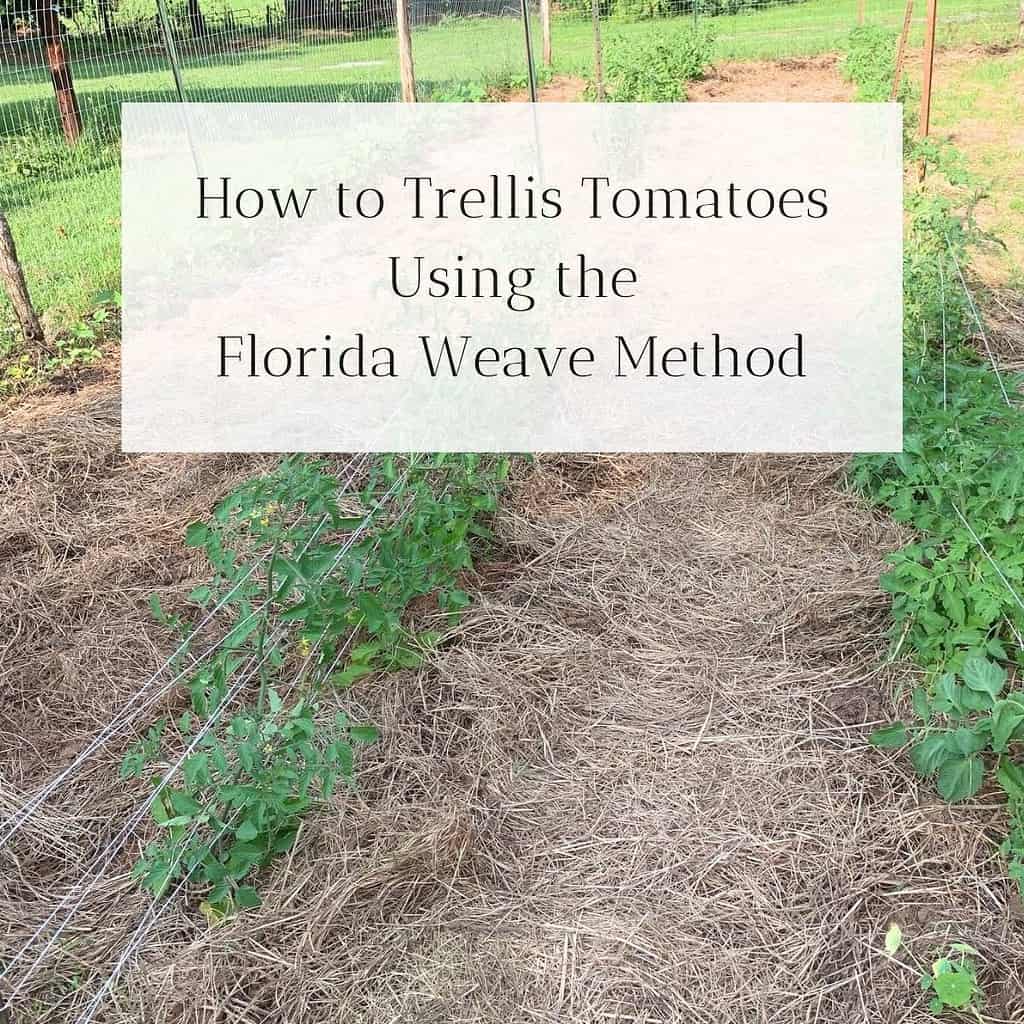
This post contains affiliate links. As an Amazon Associate I earn from qualifying purchases. That means I make a small commission at no cost to you if you place a qualifying purchase through any of the links. Read my full disclosure here. Thanks for your support!
Fresh tomatoes from the summer garden are something we look forward to every year. But honestly, managing the unruly tomato growth habits took a lot of effort.
How I used to trellis my tomatoes.

I used to put a lot of time and money into fancy trellises for my tomatoes only to be disappointed year after year. I bought and used tomato cages in my first vegetable garden. Silly me…I thought they were made for tomatoes because it was in the name!
As soon as the tomatoes outgrew their cage when they were 3 feet tall, which happens quickly in summer gardens, I struggled with how to support them. I ultimately added bamboo poles and metal stakes to the tops of the cages for the tomatoes to climb.
Adding bamboo poles and stakes to the tomato cages did make the trellis higher, but then I had to tie up the vining tomatoes to the poles every week while they grew. Each individual vine had to be tied to a pole or it would escape its cage and try to grow up the neighboring shrubs!
And the tomato cages were so cheaply made that they would bend or break rendering the cages useless.
So then I tried using only four stakes around each tomato plant and ran twine all through and around the tomato plants every week while they were growing. That worked too but it took a lot of time to do that for every tomato plant.
And the bamboo stakes would only last one season…maybe two if I was lucky…before they rotted and broke. And the metal stakes seemed to bend and break a lot, too. I had to purchase new stakes every year and that felt like money down the drain.
But then I discovered the Florida weave method to trellis my tomatoes!
What is a Florida weave trellis?
The Florida weave (or basket weave) is a method of trellising a row of plants between two posts. Jute twine or string is tied to one end post and then weaved around the stem of each plant running in a forward, backward, alternating pattern until the other post is reached. Then the string is weaved in the reverse direction.

It’s best to use heavy duty fence posts (or something similar) set no farther than 10 feet apart. Plant your tomatoes evenly between the two fence posts.
When your tomato plants start producing fruit, the weight of the fruit will pull down on the tomato branches and stems, but the weave will strengthen each plant so that they can stand upright.
And that will keep your tomatoes from touching the ground and help prevent pest problems and disease!
How to trellis tomatoes using the Florida weave.
Start off by tying your string near the bottom of your fence post.

Pull the string tightly as you walk along the garden row and have the string go in front of the first tomato plant.
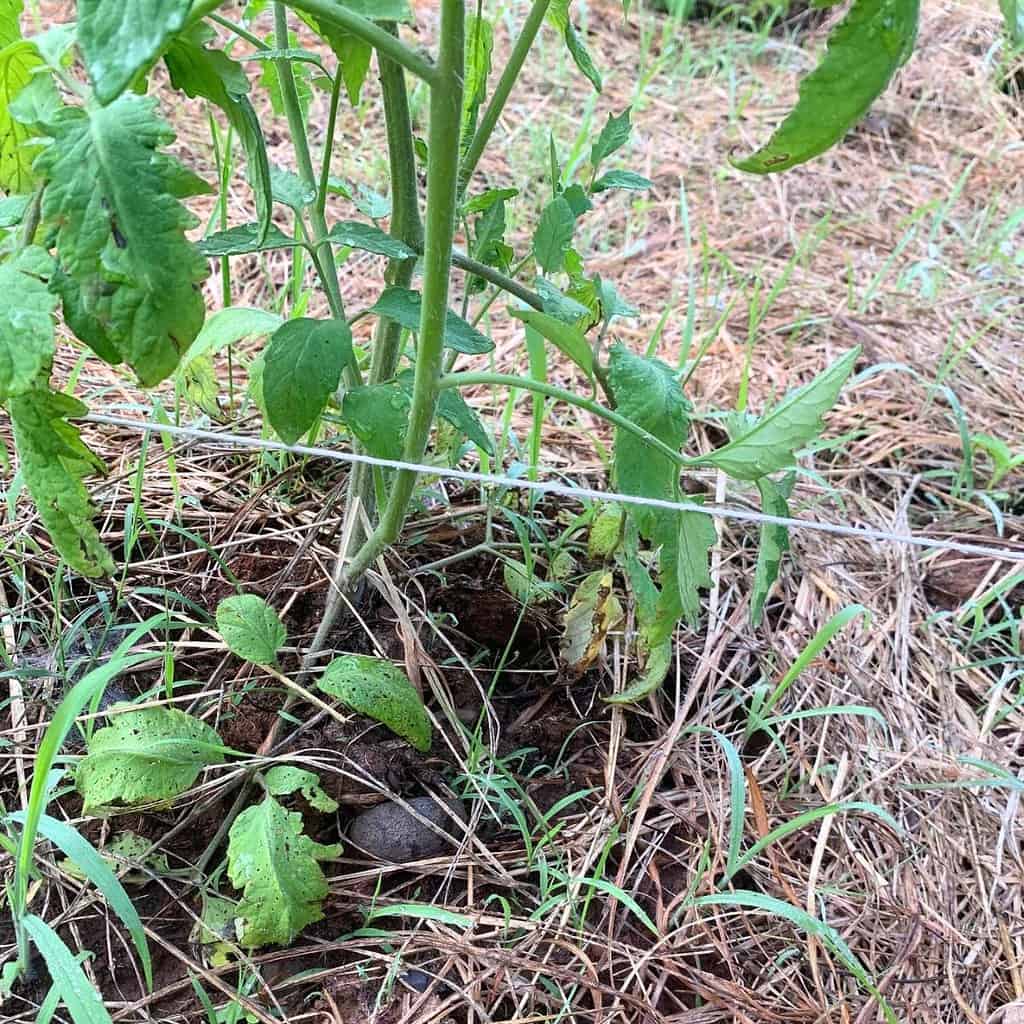
Then have the string go behind the second plant.

Alternate at each plant so that the string goes before, behind, and before each of the plants until you reach the end of the row and the other fence post.
Then wrap the string around the fence post and weave each of the plants again in the reverse direction.
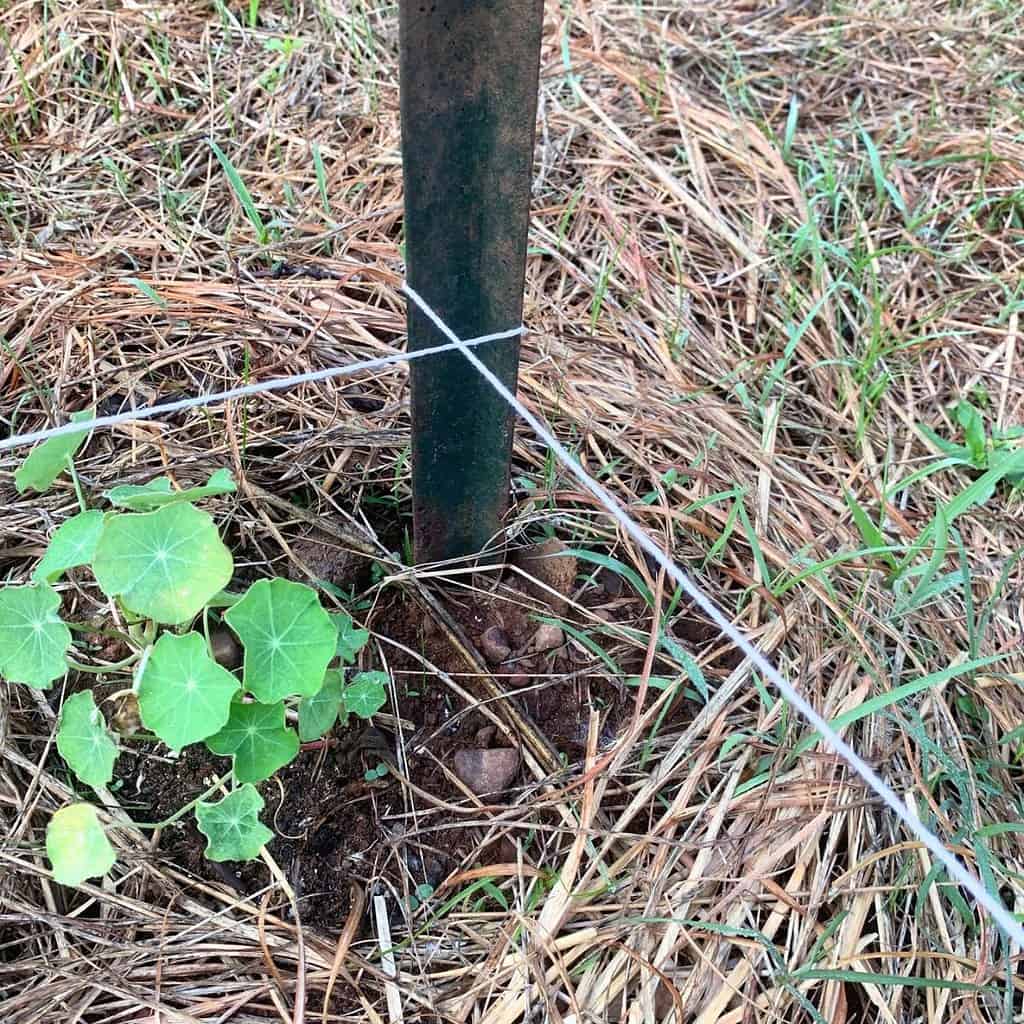
Each plant stem should have string running before and behind it.

When you get back to the first fence post, slide the string 6 to 8 inches higher and repeat the process going before and behind each plant.
Keep weaving your string between the plants and go as high as your plants are growing.
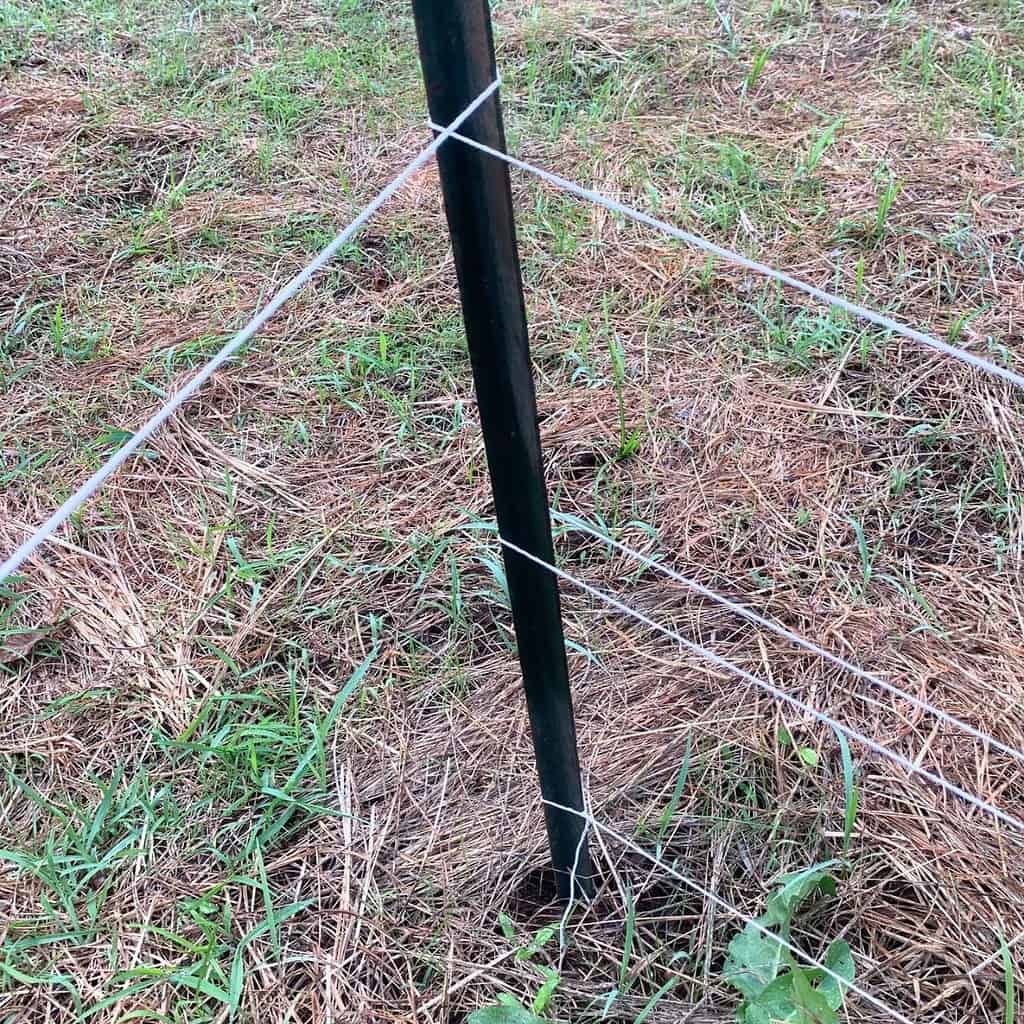
When you’ve weaved your string as high as you need, tie off your string around your fence post. A simple double-knot will do.
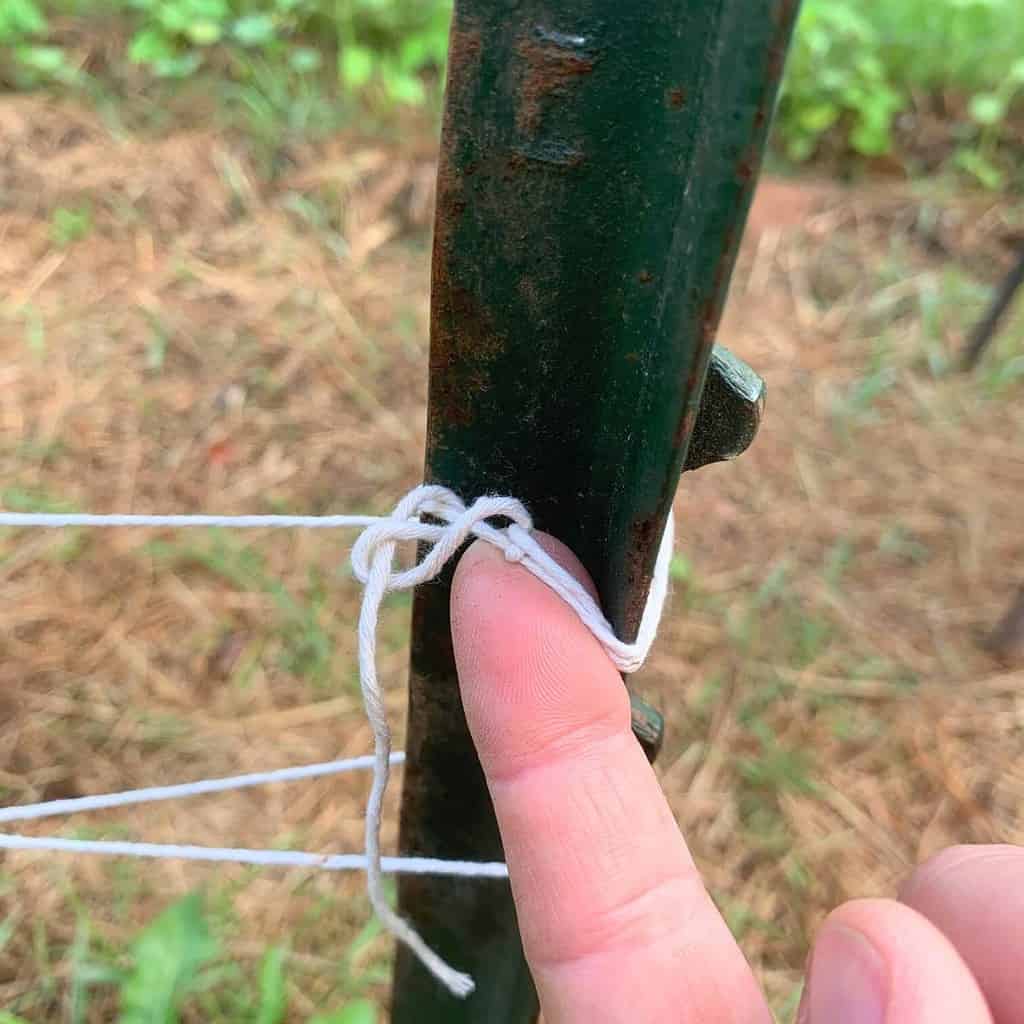
You can repeat this weaving process every week or two as your tomato plants grow higher.
And that’s it!
This is a simple, cheap, easy, and fast way to trellis a lot of tomatoes at once.
What kind of string do you use for Florida weave?
You can use any string or twine for the Florida weave but most gardeners use jute twine, sisal twine, or cotton twine because those options are cheap, natural, and biodegradable.
The most common twines used are jute twine, sisal twine, and 100% cotton twine because they are all natural, biodegradable products made from plants. Hemp twine and seagrass twine are biodegradable options but they’re more expensive.
I’ve used jute twine in the past but this year I went with cotton twine right out of my kitchen pantry because I couldn’t find my jute twine when I needed it. I particularly like the cone-shaped cotton twine that comes with its own cutter built in!
I would personally stay away from nylon twine and other synthetic materials made with a lot of plastic but use what you have on hand.
Gardening hack for doing the Florida weave.
Here’s a hack to doing the Florida weave by yourself without getting your twine tangled up. All you need is a bungee cord, rope, or belt, and a bucket of some sort with a handle.
Strap the bucket around your waist and put your twine inside. I ran my string through the little loop on the bucket handle and it stayed put inside my bucket the whole time I did the Florida weave.
It was nice to have a free hand and not worry about my twine getting tangled!

It may not be pretty but sometimes you have to be creative to get the job done.
How tall should the trellis be for tomatoes?
A trellis should be about 5 feet tall for determinate tomatoes (bush-type tomatoes that quit growing so fruit ripens within a concentrated period) and at least 6 feet tall for indeterminate tomatoes (climbing or vining tomatoes that never stop growing). But there are some exceptions.
For example, some of the newer determinate tomato varieties only grow 6 to 9 inches tall! They’re called patio tomatoes, micro tomatoes, and extra-dwarf tomatoes. For these types of short tomatoes, you don’t need to use any trellis.
Likewise, if you are very tall and don’t have any issues harvesting tomatoes growing 6 feet high or more, you can make your trellis as tall as you want. Some indeterminate tomatoes grow well over 10 feet tall!
We like to grow both determinate and indeterminate tomatoes in our garden. And we use the Florida weave for both types of tomatoes. The plants have all the support they need to set a lot of heavy fruit without the plants falling down.
Plus, the extra structure in the garden is aesthetically pleasing. It also keeps the plants upright so they get good airflow and sunshine without shading their neighbors.
How far apart should tomatoes be for the Florida weave?
Tomatoes should generally be planted about 2 feet apart for the Florida weave but the distance could change depending on other variables.
Plant indeterminate tomatoes between 2 to 3 feet apart. You don’t want them any closer because the plants will start competing for the same sunlight, soil nutrients, and water. And if you don’t plant anything else within 3 feet, it would be a waste of garden space.
Plant determinate tomatoes between 18 inches and 2 feet apart. Plant micro tomatoes that only grow about 9 inches tall as close as 8 inches apart!
Leave a comment.
I hope you found this post helpful! What’s your favorite way to trellis your tomatoes?
Shop This Post!
Other Related Posts
Can you spray soapy water on tomato plants?
How to Get Rid of Tiny Black Bugs on Tomato Plants
When and How to Pick Zucchini for the Best Harvest
Laboratory Soil Testing and Resources for Gardeners
Pin It For Later!




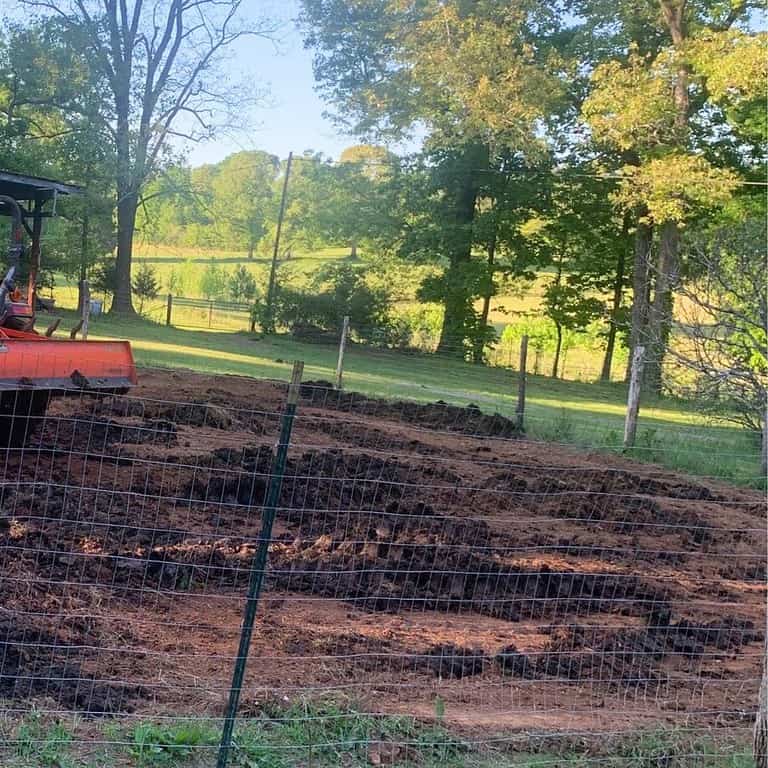
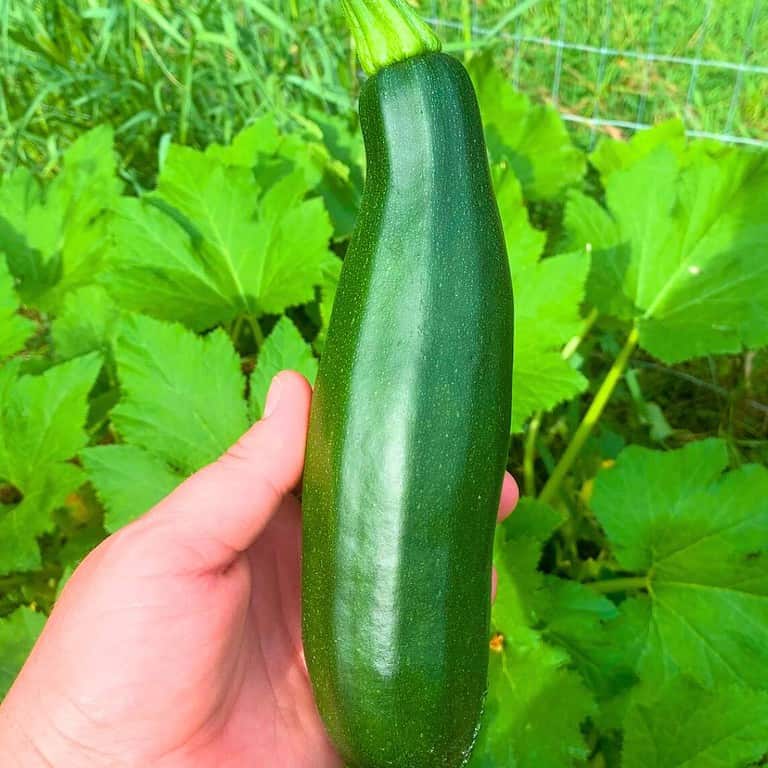

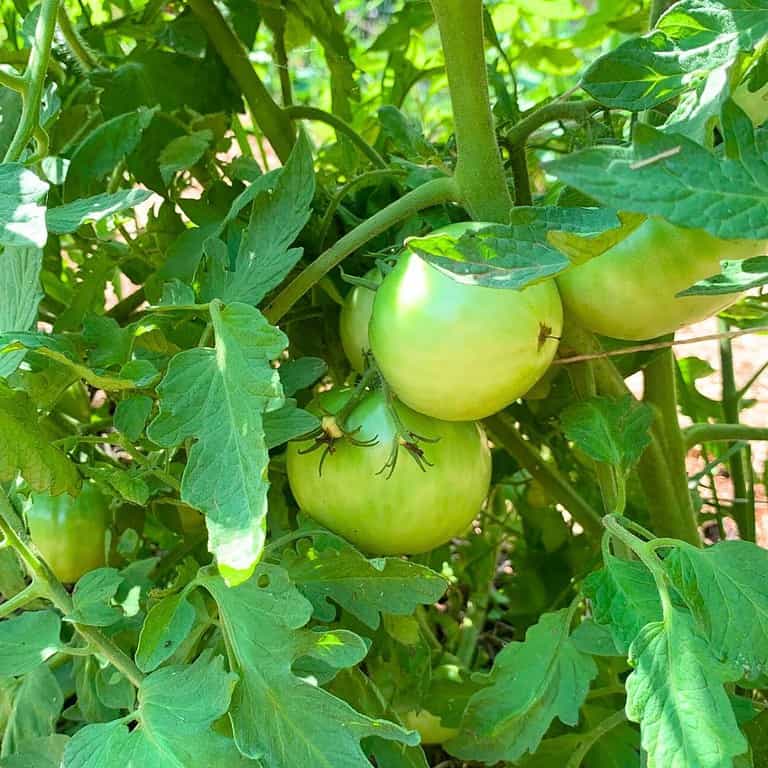
Haven’t heard of this method but it looks great. I’ll have to give it a try. Thanks!
Great post & very well-detailed! I have never of it this method, but I will surely keep this for future reference!
I’m glad you found this post helpful!
What prevents the tomatoes from falling to the left or right when they get tall and heavy? I have 3 rows of 10 tomatoes which seem to be perfect for the Florida weave. Thank you for your post.
Does bamboo become unusable because of fungus or bacteria over time? I have pieces that are 8’ which would be perfect for intermediate supports.
I think the key to preventing the tomatoes from falling to the left or right is to make sure that the twine you use is strong and pulled tight between the posts. I like to use heavy duty steel fence posts that I drive deep into the ground because 1) they have notches on the side that prevent the twine from slipping down, and 2) the anchor plate makes them sturdy enough to accommodate heavy tomato plants.
Bamboo doesn’t become unusable solely from black sooty mold, which is a common fungus in gardens. I’ve used a lot of bamboo in my gardens in the past, and my hot and humid summers are an open invitation for black sooty mold to grow on each of them. (The fungus that creates black sooty mold isn’t dangerous like black mold.) But my bamboo never lasts longer than a couple seasons because the sun and heat turn them brittle where I live. However, if your bamboo is still in really good shape and as long as the diameter is at least a few inches large (not the thin, bendy ones sold in garden centers), it should be strong enough to hold the weight of your tomatoes even if they have black sooty mold growing on them. You could always wash the sooty mold off with soap and water if you are concerned about it, though.
If you decide to use your bamboo, I would notch out the sides every 4-6 inches so that as you weave your twine around the poles, it won’t slide down the slippery bamboo. Also, make sure to drive them deep into the ground because they won’t have an anchor plate like the steel fence posts I use. Good luck! I’m curious to know how this experiment turns out, so if you give it a try, I’d love to hear back!
Great post! Do you have any pruning tips for this method?
Thanks! If you are growing determinate tomatoes, they won’t grow too tall, and you should just pinch off the suckers (the new growth that grows in between where a branch meets the stem) to control any overgrowth. That’s all the pruning that I would do with determinate tomatoes. If you are growing indeterminate tomatoes, you should remove the suckers, but you can also cut the central stem when it gets as high as you want it to grow. So for this method of growing tomatoes, you might want to cut the central stem when it reaches the height of your poles. That will make the tomato plant stop growing vertically and will force unripened fruit to hurry up and ripen. (Full disclosure: I personally don’t mind reaching overhead to collect tomatoes, so I don’t cut my central stem.)